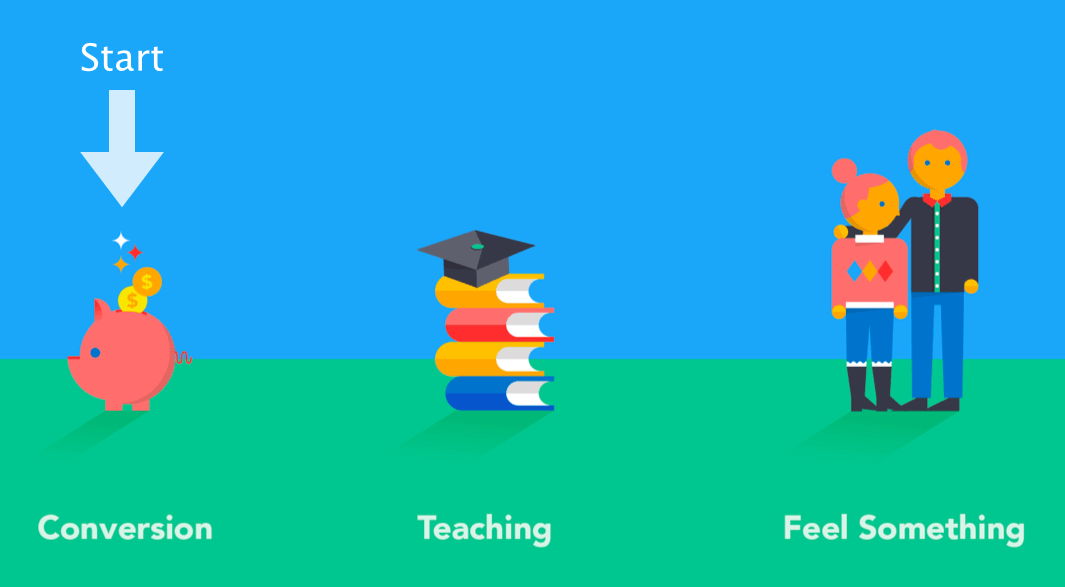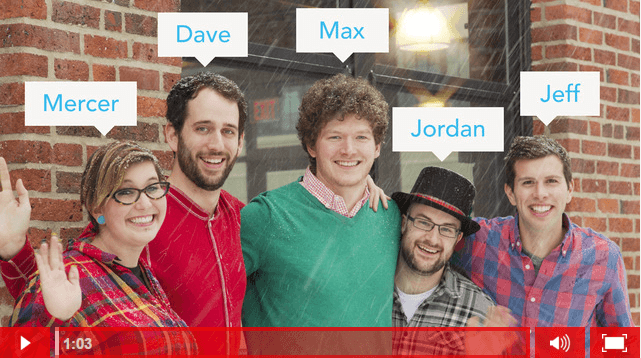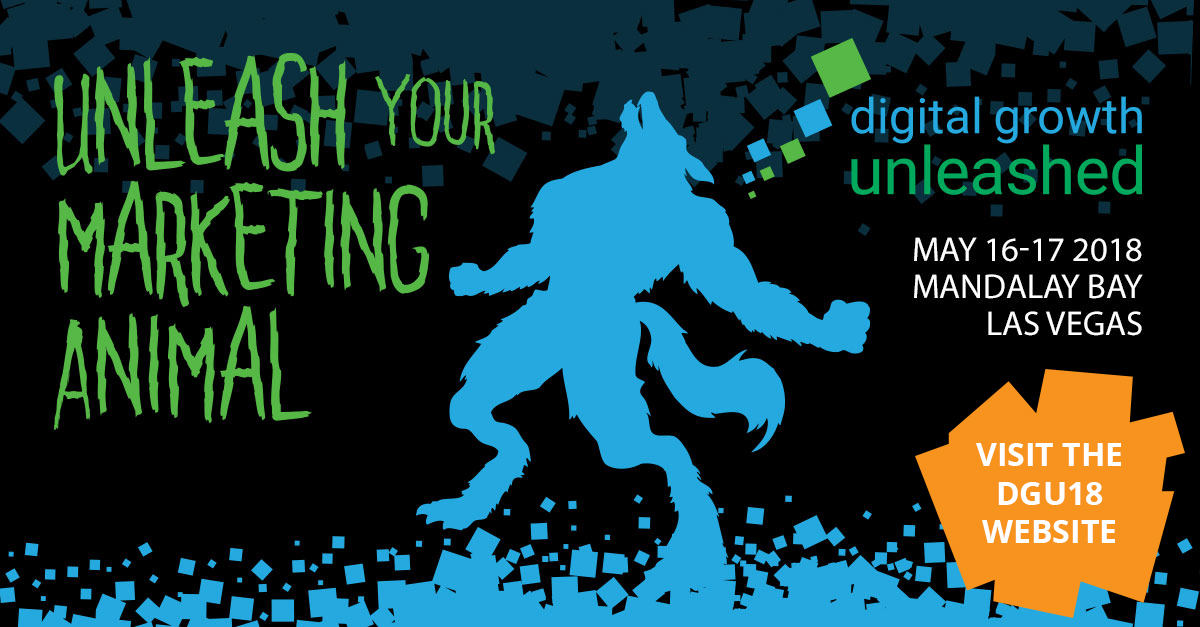Like anything else done well, great video marketing has a learning curve. Sure, there are technical things to learn about lighting, camera settings, and editing software, but there’s also critical learning and experience that’s needed to harness video in all of its strategic glory.
A key question you might be asking yourself at various stages of the process is, “how do I prove the value of my next video to myself or my boss?”
You can take some relatively straightforward actions to make a video that you can directly measure ROI for. On the other end of the spectrum, you’ll need to delve into the emotional elements of the medium, where impact is harder to measure, to harness the full power of video.
Below is a framework that I find useful for deciding how a company can best leverage video.

If you’re just getting started, it makes sense to start thinking about conversion goals. If you’ve made conversion videos but nothing else, then maybe it’s time to start expanding your goals towards saving time to better scale support and content marketing. Finally, if you’re justifying these other types of goals, it’s time to start thinking about what feelings you want your audience to have.
Target audience: Interested in video, but don’t have a lot of stuff to go back to their team with; people who are sold on video but their boss or peers aren’t.
We’re in a fortunate position here at Wistia because we get to see trends across the business videos that people push through our platform. Couple this with the fact that the types of videos businesses are choosing to make has changed pretty substantially over the last few years, and you get a unique picture of where business video is now and where it’s going.
What differentiates business videos from other online video is that business videos need to produce results. What’s surprising is that there has been a significant shift in the types of results that businesses expect from video. This shift in goals is changing the kinds of videos that are being made and even the production techniques being employed to make those videos.
I’m going to cover three of the fundamental goals for video that we’ve seen companies evolving towards increasing conversions, saving time, and scaling feelings.
Conversion Videos
 One of the biggest motivators for businesses to start using video is to increase conversion. The benefits of a conversion video can be easily understood and measured. Maybe you see more sign ups or collect more emails. Regardless of the conversion goal, conversion videos can be justified with simple math:
One of the biggest motivators for businesses to start using video is to increase conversion. The benefits of a conversion video can be easily understood and measured. Maybe you see more sign ups or collect more emails. Regardless of the conversion goal, conversion videos can be justified with simple math:
If net increase in revenue is > cost of video, you equal #winning.
In 2009, the explainer video movement really started to take off. We saw so many companies get started with explainer videos and we saw so many producers start to build explainer video production houses. Even today, I see more explainer-focused conversion videos than ever.
Here’s a great example made by Adam Lisagor of Lonely Sandwich:
Once businesses start seeing measurable results from video, they start making videos wherever they think they can increase the conversion on their sites. This even works at scale: Zappos makes over 100,000 videos every year for their product pages.
Ready for More Conversion-Boosting Tips?
Join the worldwide community of conversion optimizers at ConvCon 2017!
Teaching Videos
 Once companies start seeing measurable success with their conversion videos, they often also begin to understand the qualitative benefits that video can provide.
Once companies start seeing measurable success with their conversion videos, they often also begin to understand the qualitative benefits that video can provide.
These benefits can manifest in a lot of different ways, and they might seem small at first:
- People on camera start getting recognized in person.
- The questions coming in about a product are more evolved.
- Fewer questions come in after launching a conversion video, even though conversion increased.
In the long term, teaching videos can save you time, automate conversions, and better educate your audience.
Help Scout made this video to walk people through their application, which helps save their support team time:
This video is really helpful for someone who has already decided they’re interested in Help Scout’s software, but doesn’t really help with marketing.
On the other hand, here’s an example of a teaching video used in another light. Acoustic Guitar use their series of videos to teach people about different guitars. This allows their audience to access their expertise whenever they need it, and also makes it easy to share, furthering the company’s content marketing and building trust:
Scaling Feelings
 Ahh, finally, we make it to my favorite goal for online video: to make someone feel something. Video is a great way to save time, but beyond that, it’s the best way to scale emotions and human connection.
Ahh, finally, we make it to my favorite goal for online video: to make someone feel something. Video is a great way to save time, but beyond that, it’s the best way to scale emotions and human connection.
This is a hard place for most companies to start, but once you get there, you really begin to see the power of video as a medium. Feeling the right thing will motivate viewers to convert. Feeling the right thing will build a deeper brand connection.
It will buy you time, and it will sway your audience over to a different way of thinking. Feeling something is what video is best at helping us do. The entire entertainment industry would not exist if videos didn’t automate the process of making us feel something.
Here’s an example of a World Cup-themed conversion video that relies purely on a feeling to motivate you to learn more and purchase a new set of Beats:
At Wistia, we learned over the years that our most fun, personable videos also tended to be the most memorable and effective.
Over the holidays, we closed our office for a week so that everyone could go home to their families. We provided support during this break, but our response time was slower than usual. We decided to make a video to humanize ourselves and to delight the people who had the frustrating task of emailing us over the holidays:
We know how frustrating it can be to not get a quick support response. And it’s always frustrating if you don’t know when to expect a response. We were pleasantly surprised that not one person complained about longer support times if they watched the video. In fact, people responded by wishing us happy holidays and letting us know that it was okay that support was taking longer than usual. Show your human side can go a long way.
What does this all mean for you?
My advice is to reflect on where you find yourself in this spectrum of goals for video.
If you’re just getting started, it makes sense to start thinking about conversion videos. If you’ve made conversion videos but nothing else, then maybe it’s time to start expanding your goals towards saving time to better scale support and content marketing. And if you’re justifying these other types of goals, then it’s time to start thinking about what what feelings you want your audience to have.
It’s still very early days for business video in general, so jump on this bandwagon and let’s go straight to the moon.
This post was originally published on the Wistia Blog.
About the Author
 Chris Savage is the co-founder and CEO of Wistia. Wistia’s mission is to help everyone do more with video on their websites. Chris was named a Top Young Entrepreneur by BusinessWeek in 2009. In an era before Wistia, Chris worked in video production where he helped produce and bring to theaters an Emmy award winning feature length documentary. Chris gets amped up while talking about entrepreneurship, marketing, video, company building, and behavioral economics.
Chris Savage is the co-founder and CEO of Wistia. Wistia’s mission is to help everyone do more with video on their websites. Chris was named a Top Young Entrepreneur by BusinessWeek in 2009. In an era before Wistia, Chris worked in video production where he helped produce and bring to theaters an Emmy award winning feature length documentary. Chris gets amped up while talking about entrepreneurship, marketing, video, company building, and behavioral economics.

 717 798 3495
717 798 3495






